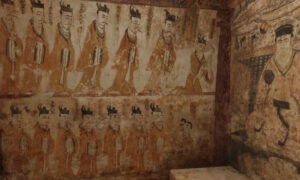The Complex of Koguryo Tombs, located in the Democratic People’s Republic of Korea, is a significant cultural heritage site from the Koguryo Kingdom, which thrived from 37 BC to 668 AD. This collection of tombs, many of which have elaborate wall paintings, offers a unique glimpse into the life, culture, and beliefs of this ancient kingdom. The tombs, mostly built for royalty and nobility, are remarkable for their scale, number, and the richness of their contents, including the murals that depict both mundane and fantastical scenes.
Koguryo Kingdom
The Koguryo Kingdom, which thrived from 37 BCE to 668 CE, was one of the three kingdoms of ancient Korea. Alongside Baekje and Silla, Koguryo played a significant role in the history of Northeast Asia. It was renowned for its military might and expansive territory that stretched from central Manchuria to the northern Korean peninsula. The kingdom of Koguryo had a highly militarized society capable of repelling invasions from other powers such as the Chinese dynasties. The capital cities of the Koguryo Kingdom, including Gungnae and later Pyongyang, were centers of political power and cultural life.
The ancient Koguryo kingdom was also known for its cultural contributions, notably in the form of tomb murals which offer a glimpse into the life, beliefs, and artistry of Koguryo people. These murals, with their vivid depictions of daily life, ceremonies, and mythology, have been instrumental in understanding the kingdom’s social structure and cultural practices. The end of the Koguryo Kingdom came about due to internal struggles and external pressures, eventually leading to its conquest by the allied forces of Silla and Tang China. Despite its collapse, Koguryo’s legacy has persisted through time and continues to be a source of national pride for modern-day Korea.

